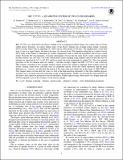KIC 7177553: A QUADRUPLE SYSTEM OF TWO CLOSE BINARIES
Author(s)
Lehmann, H.; Borkovits, T.; Ngo, H.; Mawet, D.; Csizmadia, Sz.; Rappaport, Saul A.; Forgacs-Dajka, E.; ... Show more Show less
DownloadLehmann-2016-KIC 7177553_ A QUADR.pdf (1.906Mb)
PUBLISHER_POLICY
Publisher Policy
Article is made available in accordance with the publisher's policy and may be subject to US copyright law. Please refer to the publisher's site for terms of use.
Terms of use
Metadata
Show full item recordAbstract
KIC 7177553 was observed by the Kepler satellite to be an eclipsing eccentric binary star system with an 18-day orbital period. Recently, an eclipse timing study of the Kepler binaries has revealed eclipse timing variations (ETVs) in this object with an amplitude of ~100 s and an outer period of 529 days. The implied mass of the third body is that of a super-Jupiter, but below the mass of a brown dwarf. We therefore embarked on a radial velocity (RV) study of this binary to determine its system configuration and to check the hypothesis that it hosts a giant planet. From the RV measurements, it became immediately obvious that the same Kepler target contains another eccentric binary, this one with a 16.5-day orbital period. Direct imaging using adaptive optics reveals that the two binaries are separated by 0[" over .]4 (~167 AU) and have nearly the same magnitude (to within 2%). The close angular proximity of the two binaries and very similar γ velocities strongly suggest that KIC 7177553 is one of the rare SB4 systems consisting of two eccentric binaries where at least one system is eclipsing. Both systems consist of slowly rotating, nonevolved, solar-like stars of comparable masses. From the orbital separation and the small difference in γ velocity, we infer that the period of the outer orbit most likely lies in the range of 1000–3000 yr. New images taken over the next few years, as well as the high-precision astrometry of the Gaia satellite mission, will allow us to set much narrower constraints on the system geometry. Finally, we note that the observed ETVs in the Kepler data cannot be produced by the second binary. Further spectroscopic observations on a longer timescale will be required to prove the existence of the massive planet.
Date issued
2016-02Department
Massachusetts Institute of Technology. Department of PhysicsJournal
The Astrophysical Journal
Publisher
IOP Publishing
Citation
Lehmann, H., T. Borkovits, S. A. Rappaport, H. Ngo, D. Mawet, Sz. Csizmadia, and E. Forgacs-Dajka. “KIC 7177553: A QUADRUPLE SYSTEM OF TWO CLOSE BINARIES.” The Astrophysical Journal 819, no. 1 (February 25, 2016): 33. © 2016 The American Astronomical Society
Version: Final published version
ISSN
1538-4357
0004-637X